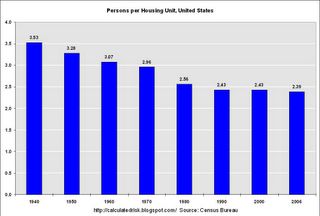by Calculated Risk on 10/05/2006 02:13:00 PM
Thursday, October 05, 2006
Fed's Kohn on Housing
Fed Vice Chairman Donald L. Kohn spoke yesterday on the U.S. Economic Outlook. Kohn made several comments regarding housing that are worth reviewing. I'm going to jump around, so please read the speech for his complete comments.
First, Dr. Kohn focused on housing starts as a metric to discuss the housing market. Click on graph for larger image.
Click on graph for larger image.
Here is a graph of housing starts since Jan 1959; the beginning of the data series from the Census Bureau. From Dr. Kohn:
"From a trough of fewer than 1.5 million units at an annual rate during the recession of 2000, starts of new single-family and multifamily homes rose to a post-World War II high of 2.2 million units last year."Kohn's recent numbers are correct, but it might be interesting to understand why Kohn is wrong about previous periods. Demographics for housing were actually more favorable in the '70s and '80s than today.
 The second chart shows the trend of people per housing unit in the United States. The number of persons per unit was trending down until around 1990 and then flattened out. There was a rapid decrease in the '70s as the boomers started forming new households en masse. The reason for the record starts in the '70s was due mostly because of the shift in the number of people per housing unit. See the following table:
The second chart shows the trend of people per housing unit in the United States. The number of persons per unit was trending down until around 1990 and then flattened out. There was a rapid decrease in the '70s as the boomers started forming new households en masse. The reason for the record starts in the '70s was due mostly because of the shift in the number of people per housing unit. See the following table:| Housing Added due to Population Growth and changes in Household Size | |||
| Decade | Due to Population Growth | Due to Change in Household Size | Total Housing Units Added |
| 1940s | 5.84 Million | 2.86 Million | 8.70 Million |
| 1950s | 9.11 | 3.08 | 12.19 |
| 1960s | 8.10 | 2.27 | 10.37 |
| 1970s | 9.05 | 10.65 | 19.70 |
| 1980s | 9.13 | 4.77 | 13.90 |
| 1990s | 13.47 | 0.13 | 13.60 |
| 2000s (through July '06) | 7.63 | 2.04 | 9.67 |
For more on Demographics see this post: Demographics and Housing Demand
More from Kohn:
"... calculations about the sustainable level of housing starts based on demographic factors, such as population growth and household formations, suggest that starts may be closer to their trough than to their peak."As Kohn noted, housing starts peaked at about 2.2 million units per year in 2005. Currently starts are at less than 1.7 million units; a decline of over 0.5 million units at an annualized start rate. So when Kohn says starts are probably closer to the "trough than to their peak", he doesn't think starts will fall to a 1.2 million unit rate.
Here is the math: The Census Bureau projects the population will grow by about 2.85 million people this year. There are approximately 2.4 people per household and this ratio is staying steady. So, all else being equal, the U.S. would need about 1.2 million units per year (edit: new starts would equal 1.2 million plus demolitions). I think Kohn might be optimistic on how far starts will fall, and this doesn't include any potential overhang from overbuilding in 2004 and 2005.
More from Kohn:
"... the fourth quarter of last year seems to provide a reasonable reference point: Since that time, housing starts have fallen about 20 percent, and home sales are down 10 percent. Home-price appreciation has also slowed dramatically since late last year, and some local markets have experienced outright price declines. Homebuilders report that cancellations have increased sharply, especially for second homes. Realtors note that existing houses are staying on the market longer, and sellers must increasingly make concessions to buyers."Reported New Home sales are off 18% from the Q4 2005 to the three most recent months. Existing Home sales are off about 12% from the peak of 2005. So I think Kohn is underestimating the decline in sales so far. And when cancellations are considered, the picture is even more bleak.
In the previous post I agreed with Kohn's assertion:
"To date there is little evidence that this correction in the housing market has had any significant adverse spillover effects on other parts of the economy."Yes, but so far there have been few BLS reported housing related job losses, and mortgage equity withdrawal (MEW) has been strong. Foreclosures have just started to rise (and rise quickly in some areas), and Kohn completely ignores any impact from the extensive use of nontraditional mortgages.
Kohn seems to be underestimating both the housing bust, underestimating the impact from the loss of jobs and MEW, and overestimating the positive demographics factors. In my view, this leads Kohn to underestimate the future impact of the housing bust on the general economy.
Last 10 Posts
In Memoriam: Doris "Tanta" Dungey
Archive
Econbrowser
Pettis: China Financial Markets
NY Times Upshot
The Big Picture
| Privacy Policy |
| Copyright © 2007 - 2023 CR4RE LLC |


